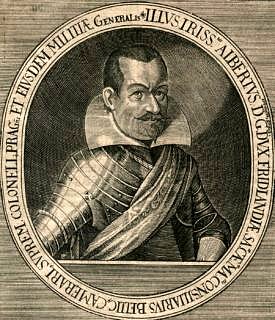International conference on the legend of Wallenstein

One of the most fascinating figures of the Thirty Years’ War is the focus of a conference that will be held in Nuremberg from 6 to 9 April 2017: Albrecht von Wallenstein (1583–1634). The researchers involved aim to discuss his vibrant personality and his legend through the ages from a variety of perspectives. The conference is being organised by researchers at FAU. It is being funded by the NÜRNBERGER Versicherungsgruppe foundation and supported by Wallenstein Festspielverein Altdorf e.V. and the town of Altdorf.
‘This will be the first time that Wallenstein has been the subject of a large research symposium,’ explained literary studies expert Prof. Dr. Dirk Niefanger and historians Prof. Dr. Georg Seiderer and Prof. Dr. Birgit Emich, the organisers of the conference, at a press conference on 8 April in Altdorf. ‘He can be used as an example to demonstrate how interdisciplinary studies lead to new and exciting research findings.’
At the conference international experts from the humanities and cultural sciences will discuss Wallenstein, his legend and his memory on the basis of five key topics.
- The first will concern the war and the fate of rulers, military leaders and soldiers, citizens and farmers.
- The second focus of the conference will be contemporary portrayals of Wallenstein, such as in pictures, pamphlets or songs.
- The third area will look at Wallenstein as a person whose personality seemed mysterious even during his own time and whose remarkable career was due to his abilities as a commander and organiser, and who despite his logical traits also sought refuge in astrology and despaired at his health problems.
- The fourth will consider Wallenstein’s reception in modern literature, music and film. Wallenstein is the subject of works by many different writers and composers, from Friedrich Schiller to Alfred Döblin and Golo Mann, and from Bedřich Smetana to Jaromir Weinberger.
- The final section of the conference will look at the international culture of memory surrounding Wallenstein. The commercialisation of the legend of Wallenstein, such as in advertising or tourism, will be a particular focus. This will be contrasted with depictions of Wallenstein and the Thirty Years’ War in museums. Researchers at the conference will also reflect upon how Wallenstein is remembered through regional festivals, such as the one in Altdorf, and in the culture of living history.
The results will be presented in 2018, which marks the 400th anniversary of the start of the Thirty Years’ War, at the Wallensteinfestspiele in Altdorf.
‘With this symposium we are highlighting the awareness of history and the excellent research carried out in the Nuremberg Metropolitan Region,’ says Hans-Peter Schmidt, chairman of the NÜRNBERGER Versicherungsgruppe foundation, ‘Friedrich-Alexander-Universität Erlangen-Nürnberg has been able to secure renowned experts from Germany and abroad to take part. Discussing this topic is a way of building a bridge to our neighbours in the Czech Republic.’
Further information:
Information and registration: www.wallensteinsymposium.de
Prof. Dr. Georg Seiderer
Professor of Modern Bavarian and Franconian Regional History and Social Anthropology
Phone: +49 9131 8522789
georg.seiderer@fau.de
Prof. Dr. Birgit Emich
Chair of Early Modern History
Phone: +49 9131 8522357
birgit.emich@fau.de
Prof. Dr. Dirk Niefanger
Chair of Modern German Literature
Phone: +49 9131 8529355
dirk.niefanger@fau.de